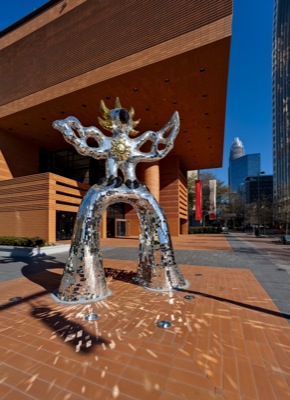
Courtesy Bechtler Museum of Art
When Swiss native Andreas Bechtler was looking for a sculpture to place in front of the new museum of modern art in his adopted home of Charlotte, N.C., he found the perfect piece in a creation by French-American artist Niki de Saint Phalle.
“Firebird,” a whimsical, bird-like creature covered in pieces of mirrored and colored glass, stands more than 17 feet tall.
“The ‘Firebird’ is joyful, uplifting and engaging,” said Bechtler. “It makes you feel that life is good.”
It is fitting that “Firebird” is quickly becoming an icon for the western North Carolina city, which is exploding in new developments that have created a vibrant, exciting destination where life is, indeed, good and choices for groups abound.
“The ‘Firebird’ is like the ‘Love’ statue is to Philadelphia,” said Stephanie Grocki, group tourism manager for Visit Charlotte. “It’s Charlotte’s photo opportunity. It’s right in front of the Bechtler and is an icon of Charlotte now.”
The Bechtler Museum of Modern Art, named for Bechtler and his family, who donated more than 1,400 artworks by major figures of 20th-century modernism to the city, is part of the Levine Center for the Arts, a complex of three major museums that have opened over the past two years in the heart of uptown Charlotte.
In addition to the Bechtler, the Levine Center features the Mint Museum Uptown and the Harvey B. Gantt Center for African-American Arts + Culture, along with the 1,200-seat Knight Theater.
“The scope of this ambitious cultural project is going to transform the way Charlotte lives,” said Kathleen Jameson, executive director of the Mint Museum Uptown.
Final piece
The Mint, which is marketing its 75th anniversary this year, was the final piece in the Levine complex when it opened its striking new 145,000-square-foot facility last October.
The five-story building has two floors of galleries, a cafe, studios, a 240-seat auditorium, an expanded museum store, a special events pavilion with an outdoor terrace and classrooms for hands-on activities for tour groups. Its most dramatic feature is a multistory atrium with a 60-foot-square glass wall with views of the urban landscape.
The expanded facility allows the Mint Museum Uptown to not only house the Mint Museum of Craft + Design, but also add American and contemporary art and works from its European art collection.
“Look for focal points like Dale Chihuly’s ‘Royal Blue Mint Chandelier’ or pieces like ‘Carolina Shout’ by acclaimed Charlotte native Romare Bearden,” said Laura Hill, marketing and communications manager for Visit Charlotte.
The opening of the Uptown Museum also allows the Mint Museum’s original location, which opened in 1936 in a former branch of the U.S. Mint as the first art museum in North Carolina, to begin reinstalling its galleries dedicated to the art of the ancient Americas, decorative arts and historic costumes.
In addition to its works by Miró, Picasso, Calder, Hepworth, Warhol, Tinguely, Le Corbusier and others, the Bechlter’s new four-story building, which opened in January 2010, is also an attraction.
Only the second museum in the United States designed by Swiss architect Mario Botta, the Bechtler has a dramatic fourth-floor exhibition gallery that is cantilevered over the street, a vaulted skylight system and a soaring glass-and-steel atrium.
“Its terra cotta-tiled facade is a work of art itself,” said Hill.
Quilt pattern exterior
The Gantt Center for African-American Arts + Culture, which opened in October 2009, also provides a dramatic architectural element to the Levine complex. Its exterior patterns are reminiscent of quilt designs from the Underground Railroad and woven textile patterns from West Africa.
The 35-year-old center promotes African-American art, culture and history. The cornerstone of its permanent collection is the Hewitt Collection of African-American Art, which features works by renowned artists such as Bearden, Henry Ossawa Tanner, Elizabeth Catlett, Jonathan Green, Jacob Lawrence, Ann Tanksley and Hale Woodruff.
Another major addition to the downtown Charlotte scene, the NASCAR Hall of Fame, marked its first anniversary in May (see page 24).
“You really have to decide what you want to focus on and get down to the nitty gritty of the group,” said Grocki. “We have the NASCAR Hall of Fame, so you can do it. But if you are not on a NASCAR tour, there are still cool things to do.”
Several other Charlotte attractions have also undergone recent expansions and renovations. The U.S. National Whitewater Center has added new activities, Discovery Place was re-imagined with extensive renovations and the Billy Graham Library has made renovations and additions.
The four-year-old Billy Graham Library complex includes his restored childhood home, which was moved from the dairy farm where he grew up three miles away. The two-story brick house is filled with personal items of the Graham family.
The entrance to the main library building, which is styled after a dairy barn, is in the shape of a cross. Although the library tour includes information about Graham’s life and career, its main focus is on the message he delivered to millions of people in crusades in 185 countries.
Last year, the library was renovated to improve its sound, add Graham’s personal library and install a custom mural painted by Thomas Kinkade.
In addition to offering a range of exciting opportunities to experience its large man-made whitewater river on rafts and kayaks, the 400-acre Whitewater Center has several other outdoor adventures, including mountain biking, rock climbing and zip lines.
High above hardwood
It’s newest feature, which opened in mid-April, is the Canopy Tour, a four-hour guided experience through the trees along the Catawba River and portions of the historic Tuckaseegee Ford and Trail. Participants travel through 14 tree platforms on a series of zips, bridges and rappels, reaching heights in excess of 60 feet in the hardwood trees.
“The Whitewater Center is just amazing,” said Grocki. “Even if you don’t feel like rafting, you can have lunch there and watch. There is a great restaurant on site. It is completely different than anything else in the world.”
The 18-month, $31.6 million renovation of Discovery Place that wound up last June featured all new science and technology exhibits along with a new brighter look to the 29-year-old science museum.
A centerpiece of the renovation is “World Alive,” the museum’s newest and largest exhibit, which explores the Earth’s biodiversity with a walk-through rain forest, a 15-tank aquarium, galleries showcasing biomes from around the world and two hands-on labs.
“Visitors can explore aquatic touch-tanks or look a moray eel in the eye,” said Hill. “In ‘Cool Stuff,’ you can lie on a bed of nails.”
Other new exhibits deal with architecture and innovation.
“It [the museum] can be used for evening events for adults, when they can get in there and play,” said Grocki.










